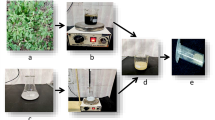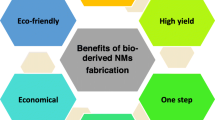Abstract
The present investigation encompasses chemical synthesis and characterisation (UV-visible spectra (UV-Vis), X-ray diffraction (XRD), dynamic light scattering (DLS), field emission scanning electron microscopy (FESEM) and high-resolution transmission electron microscopy (HRTEM)) of cadmium sulphide nanoparticles (CdS-NPs; quantum dots, possessing unique photo-physicochemical properties) and its potentiality to induce heritable phenotypic changes in Macrotyloma uniflorum (Lam.) Verdc. (Leguminosae; annual herb with therapeutic and nutritional uses). Dry seeds (moisture content 11.41 %) are exposed (3.2, 6.4, 12.7 and 19.1 μg mL−1, 24- and 48-h durations) to CdS-NPs (size: 1.2 to 2.2 nm; shape: cubic to spherical) and bulk CdS (3.2 μg mL−1, 24 h). Dissolution potentiality measured in in vitro system (using dialysis bags) shows high diffusibility (73.5 % ± 2.04 to 77.2 % ± 3.01) from lower (3.2 μg mL−1) to higher (19.1 μg mL−1) concentrations suggesting its effective penetration in in vivo system (seeds) as well. Accumulation of CdS-NPs and bulk CdS in seedlings (Petri plate germinated) is also studied in the form of Cd2+ by atomic absorption spectroscopy (AAS). CdS-NPs induce five phenotypic variants (two non-viable: ‘viridis’ and ‘glossy leaf’; three viable: ‘broad elongated leaf’, ‘bushy’ and ‘unbranched’) at M2. Selfed seeds of the variants segregated (either 3:1 or 1:1) at M3 in accordance with Mendelian pattern confirming them to be macromutants. The phenotypic mutants show normal meiotic chromosome behaviour alike to control plants (2n = 20) but with lower pollen fertility. The mutants bred true at M4 generation. ‘Broad elongated leaf’ and ‘bushy’ mutants are highly productive types (in relation to seed yield) in comparison to control plants. ‘Unbranched’ phenotype can be an important genetic resource for efficient breeding. CdS-NPs inducing heritable phenotypic changes open up the possibility of using them as an alternative source for conventional mutagens.







Similar content being viewed by others
References
Christian, P., Von der Kammer, F., Baalousha, M., Hofmann, T. (2008). Nanoparticles: structure, properties, preparation and behaviour in environmental media. Ecotoxicology, 17, 326–343. doi:10.1007/s10646-008-0213-1.
Biswas, P., & Wu, C. Y. (2005). Critical review: nanoparticles and the environment. Journal of the Air and Waste Management Association, 55, 708–746. doi:10.1080/10473289.2005.10464656.
Buzea, C., Pacheco, I. I., Robbie, K. (2007). Nanomaterials and nanoparticles: sources and toxicity. Biointerphases, 2, MR17–MR71. doi:10.1116/1.2815690.
Nowack, B., & Bucheli, T. D. (2007). Occurrence, behavior and effects of nanoparticles in the environment. Environmental Pollution, 150, 5–22. doi:10.1016/j.envpol.2007.06.006.
Tervonen, T., Linkov, I., Figueira, J. R., Steevens, J., Chappell, M., Merad, M. (2009). Risk-based classification system of nanomaterials. Journal of Nanoparticle Research, 11, 757–766. doi:10.1007/s11051-008-9546-1.
Lidén, G. (2011). The European commission tries to define nanomaterials. Annals of Occupational Hygiene, 55, 1–5. doi:10.1093/annhyg/meq092.
Rico, C. M., Majumdar, S., Duarte-Gardea, M., Peralta-Videa, J. R., Gardea-Torresdey, J. L. (2011). Interaction of nanoparticles with edible plants and their possible implications in the food chain. Journal of Agricultural and Food Chemistry, 59, 3485–3498. doi:10.1021/jf104517j.
Tan, X. M., & Fugetsu, B. (2007). Multi-walled carbon nanotubes interact with cultured rice cells: evidence of a self-defense response. Journal of Biomedical Nanotechnology, 3, 285–288. doi:10.1166/jbn.2007.035.
Landsiedel, R., Kapp, M. D., Schulz, M., Wiench, K., Oesch, F. (2009). Genotoxicity investigations on nanomaterials: methods, preparation and characterization of test material, potential artifacts and limitations—many questions, some answers. Mutation Research, 681, 2412–2458. doi:10.1016/j.mrrev.2008.10.002.
Kumari, M., Mukherjee, A., Chandrasekaran, N. (2009). Genotoxicity of silver nanoparticles in Allium cepa. Science of the Total Environment, 407, 5243–5246. doi:10.1016/j.scitotenv.2009.06.024.
Tan, X. M., Lin, C., Fugetsu, B. (2009). Studies on toxicity of multi-walled carbon nanotubes on suspension rice cells. Carbon, 47, 3479–3487. doi:10.1016/j.carbon.2009.08.018.
Kovacic, P., & Somanathan, R. (2010). Biomechanisms of nanoparticles (toxicants, antioxidants and therapeutics): electron transfer and reactive oxygen species. Journal of Nanoscience and Nanotechnology, 10, 7919–7930. doi:10.1166/jnn.2010.3028.
Shen, C. X., Zhang, Q. F., Li, J., Bi, F. C., Yao, N. (2010). Induction of programmed cell death in Arabidopsis and rice by single-wall carbon nanotubes. American Journal of Botany, 97, 1602–1609. doi:10.3732/ajb.1000073.
Hong, F., Zhou, J., Liu, C., Yang, F., Wu, C., Zheng, L., et al. (2005). Effect of nano-TiO2 on photochemical reaction of chloroplasts of spinach. Biological Trace Element Research, 105, 269–279. doi:10.1385/BTER:105:1-3:269.
Lei, Z., Mingyu, S., Chao, L., Liang, C., Hao, H., Xiao, W., et al. (2007). Effects of nanoanatase TiO2 on photosynthesis of spinach chloroplasts under different light illumination. Biological Trace Element Research, 119, 68–76. doi:10.1007/s12011-007-0047-3.
Gao, F., Liu, C., Qu, C., Zheng, L., Yang, F., Su, M., et al. (2008). Was improvement of spinach growth by nano-TiO2 treatment related to the changes of Rubisco activase? Biometals, 21, 211–217. doi:10.1007/s10534-007-9110-y.
Masarovičová, E., & Kráľová, K. (2013). Metal nanoparticles and plants. Ecological Chemistry and Engineering S, 20, 9–22. doi:10.2478/eces-2013-0001.
Manickathai, K., Viswanathan, S. K., Alagar, M. (2008). Synthesis and characterization of CdO and CdS nanoparticles. Indian Journal of Pure and Applied Physics, 46, 561–564.
Philip, D. (2010). Rapid green synthesis of spherical gold nanoparticles using Mangifera indica leaf. Spectrochimica Acta Part A: Molecular and Biomolecular Spectroscopy, 77, 807–810. doi:10.1016/j.saa.2010.08.008.
Scrinis, G., & Lyons, K. (2007). The emerging nano-corporate paradigm: Nanotechnology and the transformation of nature, food and agri-food systems. International Journal of Sociology of Agriculture and Food, 15, 22–44.
Nair, R., Varghese, S. H., Nair, B. G., Maekawa, T., Yoshida, Y., Sakthi Kumar, D. (2010). Nanoparticulate material delivery to plants. Plant Science, 179, 154–163. doi:10.1016/j.plantsci.2010.04.012.
Halder, S., Mandal, A., Das, D., Gupta, S., Chattopadhyay, A. P., Datta, A. K. (2015). Copper nanoparticle induced macromutation in Macrotyloma uniflorum (Lam.) Verdc. (Family: Leguminosae): a pioneer report. Genetic Resources and Crops Evolution, 62, 165–175. doi:10.1007/s10722-015-0216-8.
Khataee, A., Movafeghi, A., Nazari, F., Vafaei, F., Dadpour, M. R., Hanifehpour, Y., et al. (2014). The toxic effects of L-Cysteine-capped cadmium sulfide nanoparticles on the aquatic plant Spirodela polyrrhiza. Journal of Nanoparticle Research, 16, 2774. doi:10.1007/s11051-014-2774-7.
Jiang, R., Zhu, H., Li, X., Xiao, L. (2009). Visible light photocatalytic decolourization of CI Acid Red 66 by chitosan capped CdS composite nanoparticles. Chemical Engineering Journal, 152, 537–542. doi:10.1016/j.cej.2009.05.037.
Medintz, I. L., Uyeda, H. T., Goldman, E. R., Mattoussi, H. (2005). Quantum dot bioconjugates for imaging, labelling and sensing. Nature Materials, 4, 435–446. doi:10.1038/nmat1390.
Michalet, X., Pinaud, F. F., Bentolila, L. A., Tsay, J. M., Doose, S., Li, J. J., et al. (2005). Quantum dots for live cells, in vivo imaging, and diagnostics. Science, 307, 538–544. doi:10.1126/science.1104274.
Shen, Y. J., & Lee, Y. L. (2008). Assembly of CdS quantum dots onto mesoscopic TiO2 films for quantum dot-sensitized solar cell applications. Nanotechnology, 19, 1–7. doi:10.1088/0957-4484/19/04/045602.
Jagadeesh, E., Khan, B., Chandran, P., Khan, S. S. (2015). Toxic potential of iron oxide, CdS/Ag2S composite, CdS and Ag2S NPs on a fresh water alga Mougeotia sp. Colloids and Surfaces B: Biointerfaces, 125, 284–290. doi:10.1016/j.colsurfb.2014.11.008.
Munari, M., Sturve, J., Frenzilli, G., Sanders, M. B., Brunelli, A., Marcomini, A., et al. (2014). Genotoxic effects of CdS quantum dots and Ag2S nanoparticles in fish cell lines (RTG-2). Mutation Research, Genetic Toxicology and Environmental Mutagenesis, 775–776, 89–93. doi:10.1016/j.mrgentox.2014.09.003.
Morris, J. B. (2008). Macrotyloma axillare and M. uniflorum: descriptor analysis, anthocyanin indexes and potential uses. Genetic Resources and Crops Evolution, 55, 5–8. doi:10.1007/s10722-007-9298-2.
Brock, R.D. (1976). Prospects and perspectives in mutation breeding. In A. Muhammed, R. Aksel, R.C.von Borstel (Eds.), Genetic diversity in plants, part II, series title: Basic life sci, vol. 8 (pp. 117–132). New York: Plenum. doi:10.1007/978-1-4684-2886-5_12.
Kharkwal MC (2012) Impact of mutation breeding in global agriculture. In: Abstract volume of the National Symposium on Plant Cytogenetics: New Approaches-2012, Department of Botany, Punjabi University, Patiala, India, p. 31.
Salem, H. F., Eid, K. A. M., Sharaf, M. A. (2011). Formulation and evaluation of silver nanoparticles as antibacterial and antifungal agents with a minimal cytotoxic effect. International Journal of Drug Delivery, 3, 293–304.
Gao, Y., Zuo, J., Bou-Chacra, N., Pinto Tde, J., Clas, S. D., Walker, R. B., et al. (2013). In vitro release kinetics of antituberculosis drugs from nanoparticles assessed using a modified dissolution apparatus. Biomed Research International, 2013, 136590. doi:10.1155/2013/136590.
Konzak, C. F., Nilan, R. A., Wagner, J., Foster, R. J. (1965). Efficient chemical mutagenesis. The use of induced mutagenesis in plant breeding. Radiation Botany, 75, 49–70.
Gaul, H. (1964). Mutations in plant breeding. Radiation Botany, 4, 155–232. doi:10.1016/S0033-7560(64)80069-7.
Arnon, D. I. (1949). Copper enzymes in isolated chloroplasts. Poly-phenoloxidase in Beta vulgaris. Plant Physiology, 24, 1–15. doi:10.1104/pp.24.1.1.
Marks, G. E. (1954). An aceto-carmine glycerol jelly for use in pollen-fertility counts. Stain Technology, 29, 277. doi:10.3109/10520295409115483.
Prabhu, R. R., & Khadar, M. A. (2005). Characterization of chemically synthesized CdS nanoparticles. Pramana, 65, 801–807. doi:10.1007/BF02704078.
Patel, N. H., Deshpande, M. P., Bhatt, S. V., Patel, K. R., Chaki, S. H. (2014). Structural and magnetic properties of undoped and Mn doped CdS nanoparticles prepared by chemical co-precipitation method. Advanced Materials Letters, 5, 671–677. doi:10.5185/amlett.2014.1574.
Zhang, A.-Q., Tan, Q.-Z., Li, H.-J., Sui, L., Qian, D. J., Chen, M. (2014). pH-Dependent shape changes of water-soluble CdS nanoparticles. Journal of Nanoparticle Research, 16, 2197. doi:10.1007/s11051-013-2197-x.
Mercy, A., Selvaraj, R. S., Boaz, B. M., Anandhi, A., Kanagadurai, R. (2013). Synthesis, structural and optical characterisation of cadmium sulphide nanoparticles. Indian Journal of Pure and Applied Physics, 51, 448–452.
Atha, D. H., Wang, H., Petersen, E. J., Cleveland, D., Holbrook, R. D., Jaruga, P., et al. (2012). Copper oxide nanoparticle mediated DNA damage in terrestrial plant models. Environmental Science and Technology, 46, 1819–1827. doi:10.1021/es202660k.
Shi, J., Abid, A. D., Kennedy, I. M., Hristova, K. R., Silk, W. K. (2011). To duckweeds (Landoltia punctata), nanoparticulate copper oxide is more inhibitory than the soluble copper in the bulk solution. Environmental Pollution, 159, 1277–1282. doi:10.1016/j.envpol.2011.01.028.
Mushtaq, Y. K. (2011). Effect of nanoscale F3O4, TiO2 and carbon particles on cucumber seedlings germination. Journal of Environmental Science and Health. Part A, Toxic/Hazardous Substances & Environmental Engineering, 46, 1732–1735. doi:10.1080/10934529.
Stampoulis, D., Sinha, S. K., White, J. C. (2009). Assay-dependent phytotoxicity of nanoparticles to plants. Environmental Science and Technology, 43, 9473–9479. doi:10.1021/es901695c.
Lee, C. W., Mahendra, S., Zodrow, K., Li, D., Tsai, Y. C., Braam, J., et al. (2010). Developmental phytotoxicity of metal oxide nanoparticles to Arabidopsis thaliana. Environmental Toxicology and Chemistry, 29, 669–675. doi:10.1002/etc.58.
Bolbhat, S. N., & Dhumal, K. N. (2009). Induced macromutations in horsegram [Macrotyloma uniflorum (Lam.) Verdc]. Legume Research An International Journal, 32, 278–281.
Ghosh, M., Bandyopadhyay, M., Mukherjee, A. (2010). Genotoxicity of titanium dioxide (TiO2) nanoparticles at two trophic levels: Plant and human lymphocytes. Chemosphere, 81, 1253–1262. doi:10.1016/j.chemosphere.2010.09.022.
Rodriguez, E., Azevedo, R., Fernandes, P., Santos, C. (2011). Cr(VI) induces DNA damage, cell cycle arrest and polyploidization: a flow cytometric and comet assay study in Pisum sativum. Chemical Research in Toxicology, 24, 1040–1047. doi:10.1021/tx2001465.
Acknowledgments
Financial support from Department of Science and Technology-Promotion of University Research and Scientific Excellence (DST-PURSE) Programme, University of Kalyani, is gratefully acknowledged. The authors are thankful to the authority of Medicinal Plant Garden, Narendrapur Ramkrishna Mission, Government of West Bengal, India, for generous supply of seed samples. The authors are also thankful to Centre for Research in Nanoscience & Nanotechnology (CRNN), University of Calcutta, West Bengal (for FESEM, HRTEM and DLS studies), Geological Survey of India (GSI), Kolkata (XRD analysis), and Department of Zoology, University of Kalyani (AAS analysis), for various help. The authors are sincerely indebted to the anonymous reviewers for providing valuable suggestions.
Conflict of Interest
The authors declare that they have no competing interests.
Compliance with Ethical Standards
The research does not include any animals including human beings. Informed consent in this regard is not applicable.
Author information
Authors and Affiliations
Corresponding author
Rights and permissions
About this article
Cite this article
Halder, S., Mandal, A., Das, D. et al. Effective Potentiality of Synthesised CdS Nanoparticles in Inducing Genetic Variation on Macrotyloma uniflorum (Lam.) Verdc.. BioNanoSci. 5, 171–180 (2015). https://doi.org/10.1007/s12668-015-0176-7
Published:
Issue Date:
DOI: https://doi.org/10.1007/s12668-015-0176-7




